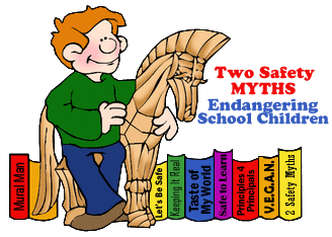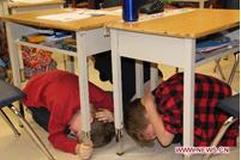 © Graphic by Phillip Martin
© Graphic by Phillip Martin You told your teachers and students to take emergency protective actions in case of earthquake or for tornado. You thought you were doing everything right because you told them, “The book and experts all agree.” Unfortunately, the voices that disagree with ‘accepted approaches’ are often censured or ignored. That’s no relief to you when you face angry parents who want to know why their child was injured, or killed, because they followed the advice you gave to their teachers. Two such pieces of advice need to be changed. These are two serious myths you should reconsider. They have been protected far too long by the originators who believe their reputations are tied to upholding these fallacies. Please consider this contrarian information. It makes sense and is based on lessons learned and sound logic.
Earthquake Immediate Actions
First, the drop-cover-and hold on mantra for earthquake safety is a direct carryover from the Cold War Era of civil defense drills. This seemed logical to some who wanted an easy connection to early drills generations had to perform in their schools. Those drills, too, were based on a myth. It was pure pabulum for anyone in a blast zone to believe that school children would be safe by hiding under a desk. On the other hand, this protective action does have some specific value for earthquakes, by keeping a close, sturdy object between our fragile bodies and falling debris—especially light fixtures and ceiling tiles. That part of the emergency action makes sense…unlike other quake protection myths like standing in a doorway because it was the safest place to stay during a strong earthquake. That idea turned out to be an absolute fallacy. So why isn’t all of the ‘drop-cover-and hold on’ approach correct?
Falls are one of the most serious accidents that can cause major damage to humans. Our natural reflex when falling forward is to put our hands and arms in front of us so we don’t strike our heads. Picture how gymnasts, martial artists and even parachutists are taught to land safely. You will note it is never on their backs. The spine is too easily damaged. If landing on their feet safely is not possible, or likely to fail, all of these professionals roll to their sides as they fall.
First, the drop-cover-and hold on mantra for earthquake safety is a direct carryover from the Cold War Era of civil defense drills. This seemed logical to some who wanted an easy connection to early drills generations had to perform in their schools. Those drills, too, were based on a myth. It was pure pabulum for anyone in a blast zone to believe that school children would be safe by hiding under a desk. On the other hand, this protective action does have some specific value for earthquakes, by keeping a close, sturdy object between our fragile bodies and falling debris—especially light fixtures and ceiling tiles. That part of the emergency action makes sense…unlike other quake protection myths like standing in a doorway because it was the safest place to stay during a strong earthquake. That idea turned out to be an absolute fallacy. So why isn’t all of the ‘drop-cover-and hold on’ approach correct?
Falls are one of the most serious accidents that can cause major damage to humans. Our natural reflex when falling forward is to put our hands and arms in front of us so we don’t strike our heads. Picture how gymnasts, martial artists and even parachutists are taught to land safely. You will note it is never on their backs. The spine is too easily damaged. If landing on their feet safely is not possible, or likely to fail, all of these professionals roll to their sides as they fall.
 Photo Source: www.news.cn
Photo Source: www.news.cn Our ribs are designed specifically to protect our most vulnerable core organs. That is another reason a fetus takes a curled position. That shape protects against injury. If we tell students to hide under desks with their backs upright, and their heads directly pointed downward, we put them at great risk for catastrophic spine and head injuries. Earthquake waves can toss objects up and down, not just side to side.
This is why I have refused to teach the ‘spine-high’ approach for many years. It makes no sense. Instead, the students should hold on to the table/chair leg while protecting their head, huddled in fetal position. In this way, they can also best create a small air space near their face, which has proven critical to quake survivors in major building collapses. One of the leading causes of death in building collapses from quakes is dust inhalation, so pulling a shirt or blouse over the mouth and nose while in fetal position may be just as critical as avoiding the initial falling debris, especially is strong quakes.
SPECIAL NOTE: This approach has nothing to do with the “Triangle of Life” hypothesis, which this author does not support as a successful strategy for immediate reduction of injury from quakes
This is why I have refused to teach the ‘spine-high’ approach for many years. It makes no sense. Instead, the students should hold on to the table/chair leg while protecting their head, huddled in fetal position. In this way, they can also best create a small air space near their face, which has proven critical to quake survivors in major building collapses. One of the leading causes of death in building collapses from quakes is dust inhalation, so pulling a shirt or blouse over the mouth and nose while in fetal position may be just as critical as avoiding the initial falling debris, especially is strong quakes.
SPECIAL NOTE: This approach has nothing to do with the “Triangle of Life” hypothesis, which this author does not support as a successful strategy for immediate reduction of injury from quakes
 ©Graphic by Phillip Martin
©Graphic by Phillip Martin Tornado Sheltering
The second myth became obvious in recent years as CCTV footage caught a school being torn apart by a powerful tornado. Until recently, emergency managers and public safety responders advised placing children in hallways with no glass present during high-wind events. Some also supported using a gymnasium as a safe site. The footage available below clearly demonstrates what happens if we relocate children to long hallways that have exit doors, or to large gyms. A central, protected, glass-free location is still my favored location, but not with overhanging lights (like the gym) or an exterior door that acts as a suction tube for external storm debris, turning the evacuation shelter point into a blender. This spectacular video should be ample proof that designation of tornado safe havens in our schools needs careful reconsideration.
The second myth became obvious in recent years as CCTV footage caught a school being torn apart by a powerful tornado. Until recently, emergency managers and public safety responders advised placing children in hallways with no glass present during high-wind events. Some also supported using a gymnasium as a safe site. The footage available below clearly demonstrates what happens if we relocate children to long hallways that have exit doors, or to large gyms. A central, protected, glass-free location is still my favored location, but not with overhanging lights (like the gym) or an exterior door that acts as a suction tube for external storm debris, turning the evacuation shelter point into a blender. This spectacular video should be ample proof that designation of tornado safe havens in our schools needs careful reconsideration.
Cameras catch the damage done as a tornado rips through an Indiana middle school's gym and hallway. Fortunately no one was in the school when the tornado hit
YouTube Video, Published on Dec 17, 2013
YouTube Video, Published on Dec 17, 2013
Summary
Ideas and strategies change based on sound consideration and evidence. If we refuse to consider critical proof for the need to evolve a process, ensuring better outcomes, then we cannot expect the results to improve. Safety rules are written in blood…but it should not be the blood of our innocent schoolchildren.
Ideas and strategies change based on sound consideration and evidence. If we refuse to consider critical proof for the need to evolve a process, ensuring better outcomes, then we cannot expect the results to improve. Safety rules are written in blood…but it should not be the blood of our innocent schoolchildren.
Ten Tips for Teachers for Safer Schools - Series by Rick Tobin
Ten Tips Series | Middle Schools & Junior High Schools | High Schools | Rick Tobin | In the News | Store
Phillip Martin's Free Clip Art
Ten Tips Series | Middle Schools & Junior High Schools | High Schools | Rick Tobin | In the News | Store
Phillip Martin's Free Clip Art


 RSS Feed
RSS Feed